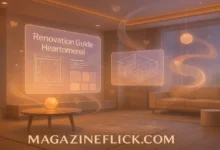How to Grow Stinging Nettle in Containers Like a Pro Gardener

Learn how to grow stinging nettle in containers with ease — from soil mix and pot choice to watering, harvesting, and care tips. A complete expert guide for home gardeners.
Introduction
If you’ve ever brushed past stinging nettle in the wild, you probably remember that tingle. But what many don’t realize is that this plant, famous for its sting, is a hidden gem for gardeners, herbalists, and health enthusiasts. Growing stinging nettle in containers is the perfect way to enjoy its many benefits without worrying about it spreading uncontrollably in your garden.
Container growing gives you full control — you can place it on a balcony, patio, or even a sunny windowsill. When grown with care, stinging nettle offers fresh leaves for teas, soups, and herbal remedies, all while acting as a powerful organic fertilizer and pollinator attractor. Let’s walk through everything you need to know to grow stinging nettle in containers like an expert.
Why Choose Containers for Stinging Nettle
Growing nettle in the ground can quickly get out of hand. It spreads aggressively through underground rhizomes and self-seeding, taking over your garden beds before you know it. Containers solve this problem beautifully. They let you enjoy nettle’s lush growth and herbal uses while keeping it contained and manageable.
Another reason to grow it in containers is convenience. You can move pots around to get the right amount of sunlight, keep them safe during harsh weather, and easily harvest fresh leaves right outside your door. Plus, if you live in an apartment or have limited space, container nettle fits perfectly into balcony or patio gardening setups.
Best Containers and Soil for Nettle
Choosing the right pot is essential to help your nettle thrive. It needs space, good drainage, and a soil mix rich in nutrients.
Clay or terracotta pots work well because they breathe and prevent soggy soil, though they dry out faster. Plastic containers retain moisture longer and are lighter to move, while fabric grow bags are excellent for air circulation. Whatever you choose, make sure it has multiple drainage holes.
As for size, aim for a pot that’s at least 10–12 inches deep and wide. This gives the roots plenty of room to spread and ensures stability for tall growth.
When it comes to soil, nettle loves rich, loamy, and slightly acidic to neutral soil. Mix together equal parts potting mix, compost, and a small amount of coarse sand or perlite for drainage. You can also add organic matter like worm castings or aged manure to boost nitrogen — nettle thrives in nitrogen-rich environments.
Planting Stinging Nettle in Containers
You can grow nettle either from seeds, root divisions, or starter plants. Each method has its perks, depending on what’s available.
From Seeds:
If starting from seed, sow them on the surface of moist soil and lightly press them in — don’t bury them too deep since they need light to germinate. Keep the soil evenly moist and warm, ideally around 70°F (21°C). Germination usually takes about two weeks. Once seedlings have a few leaves, thin them to leave one strong plant per pot.
From Root Cuttings or Transplants:
If you already have a nettle patch, dig up a small section of root with a few buds and plant it just below the soil surface. This method is faster and gives you a head start since it skips the fragile seedling stage. Water thoroughly and keep it in partial shade until new growth appears.
Light, Temperature, and Moisture Needs
Stinging nettle enjoys bright but gentle light. It grows well in partial sun or filtered light, though it can handle full sun in cooler climates. Ideally, aim for about six hours of sunlight daily. If you live somewhere hot, protect your container from harsh afternoon rays to prevent wilting.
Watering is where most people go wrong. Nettle loves consistently moist soil, but it doesn’t tolerate sogginess. Check the top inch of soil; if it feels dry, water deeply until it drains from the bottom. During hot days, you may need to water daily. Mulching with shredded leaves or straw helps retain moisture and stabilize temperature.
Nettle is quite hardy. It can handle cool weather and light frost but prefers temperatures between 55°F and 75°F. If winter temperatures drop below freezing, protect your container or move it indoors to a sheltered spot.
Feeding and Fertilizing Nettle in Pots
Nettle is a nutrient-loving plant. Because container soil loses nutrients faster than garden beds, you’ll need to feed it regularly.
Mix compost into the soil every few weeks, or add a layer of organic mulch on top. You can also use a liquid organic fertilizer like fish emulsion or seaweed extract once or twice a month during the growing season.
Here’s a quick reference table for easy feeding:
| Fertilizer Type | Frequency | Benefit |
|---|---|---|
| Compost tea | Every 2–3 weeks | Boosts overall growth and leaf color |
| Fish emulsion | Monthly | Adds nitrogen and trace minerals |
| Aged manure | Seasonal top-up | Improves soil structure and nutrition |
| Seaweed extract | Every 4 weeks | Promotes resilience and vigor |
Keeping soil rich ensures lush, green foliage perfect for harvesting.
Maintaining Healthy Growth
To keep your stinging nettle strong and bushy, trim it regularly. Pruning encourages fresh shoots and prevents the plant from going to seed too early. Once it starts flowering, leaves can become tough and less flavorful, so pinch off flower buds as they appear.
If your plant outgrows its pot, gently lift it out and repot it into a larger container. This prevents root binding and keeps the plant thriving year after year.
Check for pests occasionally — aphids and spider mites can appear, especially indoors. Use neem oil spray or a mild soap solution to control infestations naturally. Avoid overwatering, which can lead to root rot.
Harvesting Stinging Nettle
Harvesting nettle is where the fun begins — but it’s also when you need to be cautious. Always wear gloves and long sleeves when handling fresh nettles to avoid skin irritation.
The best time to harvest is in spring or early summer, when the leaves are young and tender. Use scissors to cut the top few inches of growth, leaving enough foliage for the plant to recover. Regular harvesting encourages new, soft shoots.
After cutting, wash the leaves and blanch or dry them to neutralize the sting. Cooked or dried nettles are completely safe to handle and make delicious tea, soup, or herbal tonics.
Overwintering Your Container Nettle
If you live in a cold climate, your nettle will die back in winter but return in spring. To help it survive, cut back the stems in late autumn, reduce watering, and move the pot to a sheltered spot — such as a garage, greenhouse, or covered porch.
You can also insulate the pot by wrapping it in burlap or bubble wrap to protect the roots from freezing. Keep the soil barely moist throughout the dormant months. Once temperatures rise again, new shoots will emerge quickly.
Uses and Benefits of Stinging Nettle
Stinging nettle isn’t just a plant — it’s a powerhouse of health and garden benefits. The leaves are packed with iron, calcium, and vitamins, making them great for herbal teas or as a spinach substitute in recipes.
Gardeners love using nettle leaves to make “nettle tea fertilizer,” a natural plant tonic rich in nitrogen and minerals. Simply steep fresh leaves in water for a couple of weeks, strain the liquid, dilute it, and use it to feed other plants. It’s like a green energy drink for your garden.
Nettle also attracts pollinators and beneficial insects like ladybugs and butterflies, helping maintain biodiversity in your small garden ecosystem.
Expert Tips for Success
- Always wear gloves when pruning or harvesting fresh nettle.
- Use filtered or rainwater if possible; nettles dislike chemical-heavy tap water.
- Rotate containers occasionally to promote even sunlight exposure.
- Keep the soil consistently moist but never soggy.
- Feed regularly with compost or liquid fertilizer during active growth.
- Harvest often — young leaves taste better and keep the plant healthy.
FAQs
Q:1 Can I grow stinging nettle indoors?
Yes, nettle can grow indoors if it gets enough light. Place it near a bright window or use a grow light for 6–8 hours a day. Keep humidity moderate and water frequently.
Q:2 Does nettle sting even in containers?
Absolutely — its stinging hairs remain active until cooked or dried. Handle carefully and always wear gloves.
Q:3 How long does it take to grow nettle from seed?
Seeds germinate in about two weeks, and plants reach harvest size within two to three months under ideal conditions.
Q:4 Can I grow nettle with other herbs?
Yes, but keep it in its own pot to prevent crowding. It pairs well near mint, basil, and chamomile, which enjoy similar conditions.
Q:5 What’s the best way to store harvested nettle?
Dry the leaves completely and store them in airtight jars away from sunlight. Dried nettle keeps its nutrients for up to a year.
Conclusion
Growing stinging nettle in containers is one of the smartest ways to enjoy this remarkable herb without letting it take over your garden. With the right pot, soil, and care, you can have a steady supply of fresh leaves for teas, tonics, or cooking all year long.
This plant is as resilient as it is rewarding — once you understand its needs, it practically thrives on minimal attention. Whether you’re an herbalist, a home gardener, or just curious about sustainable growing, stinging nettle in containers offers beauty, utility, and a touch of the wild — right at your doorstep.





